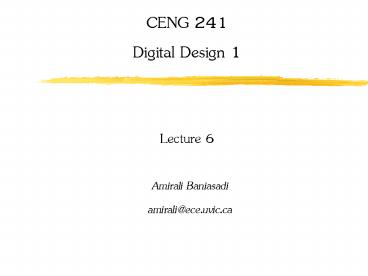CENG 241 Digital Design 1 Lecture 6 - PowerPoint PPT Presentation
1 / 21
Title:
CENG 241 Digital Design 1 Lecture 6
Description:
Combinational Logic: Output only depends on current input ... Multiplicand is multiplied by each bit of the multiplier. 15. Binary Multiplier. 16 ... – PowerPoint PPT presentation
Number of Views:79
Avg rating:3.0/5.0
Title: CENG 241 Digital Design 1 Lecture 6
1
CENG 241Digital Design 1Lecture 6
- Amirali Baniasadi
- amirali_at_ece.uvic.ca
2
Combinational Logic
- HW3 posted. Due Monday June 9th.
- Chapter 4 Combinational Logic
3
Combinational Logic
Combinational Logic Output only depends on
current input Sequential LogicOutput depends on
current and previous inputs
4
Design Procedure
- 1.The number of inputs and outputs?
- 2.Derive the truth table
- 3.Obtain the Boolean Function
- 4.Draw the logic diagram, verify correctness
5
Design Procedure example
- Binary Adder-Subtractor
- Basic block is a half adder.
- Half Adder Design
- 1.needs 2 inputs 2 outputs
- 2. Truth Table
- x y C S
- 0 0 0 0
- 0 1 0 1
- 1 0 0 1
- 1 1 1 0
- 3. Sxyxy Cxy
6
Half Adder circuit
7
Full Adder?
- Truth Table
- x y z C S
- 0 0 0 0 0
- 0 0 1 0 1
- 0 1 0 0 1
- 0 1 1 1 0
- 1 0 0 0 1
- 1 0 1 1 0
- 1 1 0 1 0
- 1 1 1 1 1
8
Full Adder Map
9
Full Adder Circuit
10
Full Adder Circuit
Half adder ?
11
4-bit Adder Circuit
But this is slow...
12
Binary Subtractor
- Subtraction is done by using complements
- As 2s Complement A1
- A-B A B1
13
4-bit adder subtractor
14
Binary Multiplier
- Binary mult. Is done the same way of decimal
mult. - Multiplicand is multiplied by each bit of the
multiplier.
15
Binary Multiplier
16
4-bit by 3-bit Binary Multiplier
B3 B2 B1 B0
A2 A1 A0 A0B3
A0B2 A0B1 A0B0 A1B3 A1B2 A1B1
A1B0 A2B3 A2B2 A2B1 A2B0
17
Decimal adder
- When dealing with decimal numbers BCD code is
used. - A decimal adders requires at least 9 inputs and 5
outputs. - BCD adder each input does not exceed 9, the
output can not exceed 19 - How are decimal numbers presented in BCD?
- Decimal Binary BCD
- 9 1001 1001
- 19 10011
(0001)(1001) -
1 9
18
Decimal Adder
- Decimal numbers should be represented in binary
code number. - Example BCD adder
- Suppose we apply two BCD numbers to a binary
adder then - The result will be in binary and ranges from 0
through 19. - Binary sum K(carry) Z8 Z4 Z2 Z1
- BCD sum C(carry) S8 S4 S2 S1
- For numbers equal or less than 1001 binary and
BCD are identical. - For numbers more than 1001, we should add 6(0110)
to binary to get BCD. - example 10011(binary) 11001(BCD) 19
- ADD 6 to correct.
19
BCD adder
Numbers that need correction (add 6) are 01010
(10) 01011 (11) 01100 (12) 01101 (13) 01110
(14) 01111 (15) 10000 (16) 10001 (17) 10010
(18) 10011 (19)
Decides to add 6?
Adds 6
20
BCD adder
Numbers that need correction (add 6) are K Z8 Z4
Z2 Z1 0 1 0 1 0 (10) 0 1 0 1 1
(11) 0 1 1 0 0 (12) 0 1 1 0 1
(13) 0 1 1 1 0 (14) 0 1 1 1 1
(15) 1 0 0 0 0 (16) 1 0 0 0 1
(17) 1 0 0 1 0 (18) 1 0 0 1 1
(19)
C K Z8Z4 Z8Z2
21
Summary
- Reading up to p. 144
- Binary/DECIMAL adder/subtractor multiplier
- Homework 3 Chapter 4 problems 5,6(a),9, 20(a)
- Due Monday June 9th.































![CS3104: ?????? Principles of Digital Design [project2] floating-point number addition PowerPoint PPT Presentation](https://s3.amazonaws.com/images.powershow.com/8016500.th0.jpg?_=20160728018)